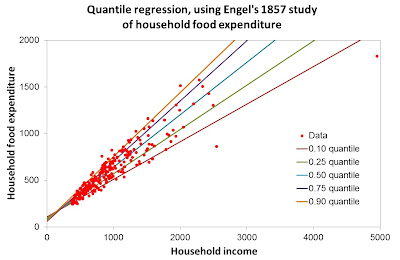| John Morrissey, Paul Hipes and Brian Spector offering the benefit of their numerical expertise in the NAG Clinic at The Trading Show Chicago |
Following a plenary session on the opening day of the conference, the proceedings were split into four streams: Trading Congress, HFT World, Quant Invest and Exchange Technology. There was a very nice talk by Professor Emanuel Derman on the use of metaphor, models and theory by quants; I had a brief chat with Derman afterwards, during which he referred to NAG in positive terms. After the conference, my colleague kindly lent me Derman’s book, "My Life As A Quant" which provides some valuable insights on his evolving views about the applicability of models to quantitative analysis, as well as interesting background on his personal history (he started his academic career as a particle physicist, switching to finance when he joined Goldman Sachs in 1985 to become one of the first so-called POWS – i.e. Physicists On Wall Street).
Another good talk was that by Ram Ahluwalia on human bias and machine learning for hedge funds, which contained some stimulating technical detail on random matrix theory and principal components analysis. His blog is built around questions and answers for finance professionals and academics; for example, a recent query about finding the nearest correlation matrix contained an approving reference to a paper by Professor Nick Higham and his colleagues on the subject (the method described therein has just been implemented in the latest release of the NAG Library - see, for example, here).
| Brian Spector explaining an abstruse technical point to me in the NAG Clinic. |
My seminar – “A cure for the common code”, which described NAG’s offerings for quants, and suggested that using some of our routines to provide the 'numerical heavy lifting' would allow developers to concentrate their effort on the more domain-specific parts of their application – was well-attended, and seemed to go over well, judging by the number of questions asked. Following the talk, many attendees availed themselves of the opportunity to visit the nearby NAG booth.
This meeting was the first occasion on which the booth was supplemented by the NAG Clinic, which offered a complementary consulting resource that offered advice and insights on business problems requiring sophisticated numerical analytics and computation. The clinic was staffed by John Morrissey and Brian Spector from the technical team at NAG Inc., Paul Hipes, who's an independent consultant providing specialist analytical software (often using NAG's components) to the financial services industry, and (intermittently) myself. The discussions with attendees yielded valuable insights into the detailed numerical requirements of quants, and gave us many useful further contacts in the field.
Finally, as in the case of the INFORMS meeting earlier this year, I found that the conference location (on Chicago's Navy Pier, just along from the Ferris Wheel, the Smith Museum of Stained Glass, and next to the beer garden) provided almost as much stimulation as the meeting itself.





















